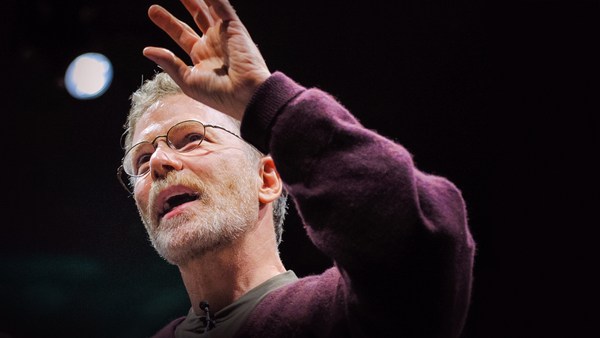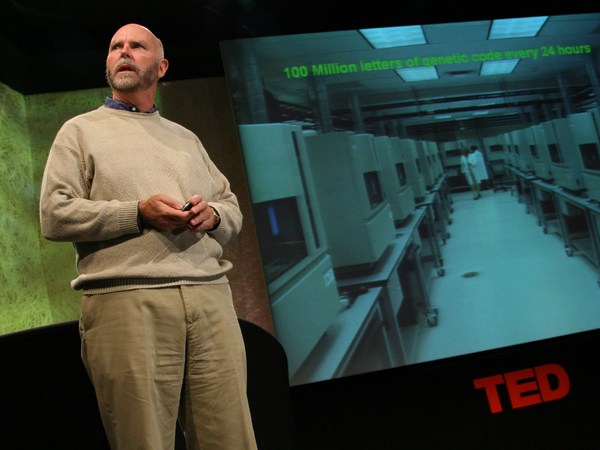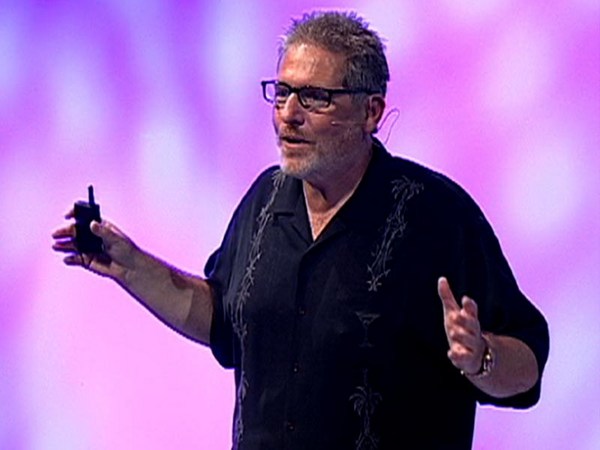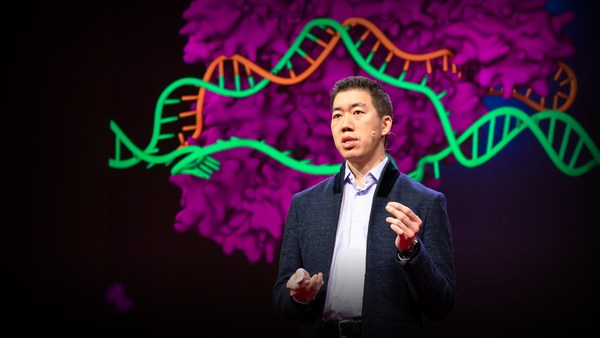We're here today to announce the first synthetic cell, a cell made by starting with the digital code in the computer, building the chromosome from four bottles of chemicals, assembling that chromosome in yeast, transplanting it into a recipient bacterial cell and transforming that cell into a new bacterial species. So this is the first self-replicating species that we've had on the planet whose parent is a computer. It also is the first species to have its own website encoded in its genetic code. But we'll talk more about the watermarks in a minute.
This is a project that had its inception 15 years ago when our team then -- we called the institute TIGR -- was involved in sequencing the first two genomes in history. We did Haemophilus influenzae and then the smallest genome of a self-replicating organism, that of Mycoplasma genitalium. And as soon as we had these two sequences we thought, if this is supposed to be the smallest genome of a self-replicating species, could there be even a smaller genome? Could we understand the basis of cellular life at the genetic level? It's been a 15-year quest just to get to the starting point now to be able to answer those questions, because it's very difficult to eliminate multiple genes from a cell. You can only do them one at a time. We decided early on that we had to take a synthetic route, even though nobody had been there before, to see if we could synthesize a bacterial chromosome so we could actually vary the gene content to understand the essential genes for life. That started our 15-year quest to get here.
But before we did the first experiments, we actually asked Art Caplan's team at the University of Pennsylvania to undertake a review of what the risks, the challenges, the ethics around creating new species in the laboratory were because it hadn't been done before. They spent about two years reviewing that independently and published their results in Science in 1999. Ham and I took two years off as a side project to sequence the human genome, but as soon as that was done we got back to the task at hand.
In 2002, we started a new institute, the Institute for Biological Energy Alternatives, where we set out two goals: One, to understand the impact of our technology on the environment, and how to understand the environment better, and two, to start down this process of making synthetic life to understand basic life. In 2003, we published our first success. So Ham Smith and Clyde Hutchison developed some new methods for making error-free DNA at a small level. Our first task was a 5,000-letter code bacteriophage, a virus that attacks only E. coli. So that was the phage phi X 174, which was chosen for historical reasons. It was the first DNA phage, DNA virus, DNA genome that was actually sequenced. So once we realized that we could make 5,000-base pair viral-sized pieces, we thought, we at least have the means then to try and make serially lots of these pieces to be able to eventually assemble them together to make this mega base chromosome. So, substantially larger than we even thought we would go initially.
There were several steps to this. There were two sides: We had to solve the chemistry for making large DNA molecules, and we had to solve the biological side of how, if we had this new chemical entity, how would we boot it up, activate it in a recipient cell. We had two teams working in parallel: one team on the chemistry, and the other on trying to be able to transplant entire chromosomes to get new cells. When we started this out, we thought the synthesis would be the biggest problem, which is why we chose the smallest genome.
And some of you have noticed that we switched from the smallest genome to a much larger one. And we can walk through the reasons for that, but basically the small cell took on the order of one to two months to get results from, whereas the larger, faster-growing cell takes only two days. So there's only so many cycles we could go through in a year at six weeks per cycle. And you should know that basically 99, probably 99 percent plus of our experiments failed. So this was a debugging, problem-solving scenario from the beginning because there was no recipe of how to get there.
So, one of the most important publications we had was in 2007. Carole Lartigue led the effort to actually transplant a bacterial chromosome from one bacteria to another. I think philosophically, that was one of the most important papers that we've ever done because it showed how dynamic life was. And we knew, once that worked, that we actually had a chance if we could make the synthetic chromosomes to do the same with those. We didn't know that it was going to take us several years more to get there.
In 2008, we reported the complete synthesis of the Mycoplasma genitalium genome, a little over 500,000 letters of genetic code, but we have not yet succeeded in booting up that chromosome. We think in part, because of its slow growth and, in part, cells have all kinds of unique defense mechanisms to keep these events from happening. It turned out the cell that we were trying to transplant into had a nuclease, an enzyme that chews up DNA on its surface, and was happy to eat the synthetic DNA that we gave it and never got transplantations. But at the time, that was the largest molecule of a defined structure that had been made.
And so both sides were progressing, but part of the synthesis had to be accomplished or was able to be accomplished using yeast, putting the fragments in yeast and yeast would assemble these for us. It's an amazing step forward, but we had a problem because now we had the bacterial chromosomes growing in yeast. So in addition to doing the transplant, we had to find out how to get a bacterial chromosome out of the eukaryotic yeast into a form where we could transplant it into a recipient cell.
So our team developed new techniques for actually growing, cloning entire bacterial chromosomes in yeast. So we took the same mycoides genome that Carole had initially transplanted, and we grew that in yeast as an artificial chromosome. And we thought this would be a great test bed for learning how to get chromosomes out of yeast and transplant them. When we did these experiments, though, we could get the chromosome out of yeast but it wouldn't transplant and boot up a cell. That little issue took the team two years to solve.
It turns out, the DNA in the bacterial cell was actually methylated, and the methylation protects it from the restriction enzyme, from digesting the DNA. So what we found is if we took the chromosome out of yeast and methylated it, we could then transplant it. Further advances came when the team removed the restriction enzyme genes from the recipient capricolum cell. And once we had done that, now we can take naked DNA out of yeast and transplant it.
So last fall when we published the results of that work in Science, we all became overconfident and were sure we were only a few weeks away from being able to now boot up a chromosome out of yeast. Because of the problems with Mycoplasma genitalium and its slow growth about a year and a half ago, we decided to synthesize the much larger chromosome, the mycoides chromosome, knowing that we had the biology worked out on that for transplantation. And Dan led the team for the synthesis of this over one-million-base pair chromosome. But it turned out it wasn't going to be as simple in the end, and it set us back three months because we had one error out of over a million base pairs in that sequence.
So the team developed new debugging software, where we could test each synthetic fragment to see if it would grow in a background of wild type DNA. And we found that 10 out of the 11 100,000-base pair pieces we synthesized were completely accurate and compatible with a life-forming sequence. We narrowed it down to one fragment; we sequenced it and found just one base pair had been deleted in an essential gene. So accuracy is essential. There's parts of the genome where it cannot tolerate even a single error, and then there's parts of the genome where we can put in large blocks of DNA, as we did with the watermarks, and it can tolerate all kinds of errors. So it took about three months to find that error and repair it. And then early one morning, at 6 a.m. we got a text from Dan saying that, now, the first blue colonies existed.
So, it's been a long route to get here: 15 years from the beginning. We felt one of the tenets of this field was to make absolutely certain we could distinguish synthetic DNA from natural DNA. Early on, when you're working in a new area of science, you have to think about all the pitfalls and things that could lead you to believe that you had done something when you hadn't, and, even worse, leading others to believe it. So, we thought the worst problem would be a single molecule contamination of the native chromosome, leading us to believe that we actually had created a synthetic cell, when it would have been just a contaminant.
So early on, we developed the notion of putting in watermarks in the DNA to absolutely make clear that the DNA was synthetic. And the first chromosome we built in 2008 -- the 500,000-base pair one -- we simply assigned the names of the authors of the chromosome into the genetic code, but it was using just amino acid single letter translations, which leaves out certain letters of the alphabet. So the team actually developed a new code within the code within the code. So it's a new code for interpreting and writing messages in DNA. Now, mathematicians have been hiding and writing messages in the genetic code for a long time, but it's clear they were mathematicians and not biologists because, if you write long messages with the code that the mathematicians developed, it would more than likely lead to new proteins being synthesized with unknown functions.
So the code that Mike Montague and the team developed actually puts frequent stop codons, so it's a different alphabet but allows us to use the entire English alphabet with punctuation and numbers. So, there are four major watermarks all over 1,000 base pairs of genetic code. The first one actually contains within it this code for interpreting the rest of the genetic code. So in the remaining information, in the watermarks, contain the names of, I think it's 46 different authors and key contributors to getting the project to this stage. And we also built in a website address so that if somebody decodes the code within the code within the code, they can send an email to that address. So it's clearly distinguishable from any other species, having 46 names in it, its own web address. And we added three quotations, because with the first genome we were criticized for not trying to say something more profound than just signing the work.
So we won't give the rest of the code, but we will give the three quotations. The first is, "To live, to err, to fall, to triumph and to recreate life out of life." It's a James Joyce quote. The second quotation is, "See things not as they are, but as they might be." It's a quote from the "American Prometheus" book on Robert Oppenheimer. And the last one is a Richard Feynman quote: "What I cannot build, I cannot understand." So, because this is as much a philosophical advance as a technical advance in science, we tried to deal with both the philosophical and the technical side.
The last thing I want to say before turning it over to questions is that the extensive work that we've done -- asking for ethical review, pushing the envelope on that side as well as the technical side -- this has been broadly discussed in the scientific community, in the policy community and at the highest levels of the federal government. Even with this announcement, as we did in 2003 -- that work was funded by the Department of Energy, so the work was reviewed at the level of the White House, trying to decide whether to classify the work or publish it. And they came down on the side of open publication, which is the right approach -- we've briefed the White House, we've briefed members of Congress, we've tried to take and push the policy issues in parallel with the scientific advances.
So with that, I would like to open it first to the floor for questions. Yes, in the back.
Reporter: Could you explain, in layman's terms, how significant a breakthrough this is please?
Craig Venter: Can we explain how significant this is? I'm not sure we're the ones that should be explaining how significant it is. It's significant to us. Perhaps it's a giant philosophical change in how we view life. We actually view it as a baby step in terms of, it's taken us 15 years to be able to do the experiment we wanted to do 15 years ago on understanding life at its basic level. But we actually believe this is going to be a very powerful set of tools and we're already starting in numerous avenues to use this tool.
We have, at the Institute, ongoing funding now from NIH in a program with Novartis to try and use these new synthetic DNA tools to perhaps make the flu vaccine that you might get next year. Because instead of taking weeks to months to make these, Dan's team can now make these in less than 24 hours. So when you see how long it took to get an H1N1 vaccine out, we think we can shorten that process quite substantially. In the vaccine area, Synthetic Genomics and the Institute are forming a new vaccine company because we think these tools can affect vaccines to diseases that haven't been possible to date, things where the viruses rapidly evolve, such with rhinovirus. Wouldn't it be nice to have something that actually blocked common colds? Or, more importantly, HIV, where the virus evolves so quickly the vaccines that are made today can't keep up with those evolutionary changes.
Also, at Synthetic Genomics, we've been working on major environmental issues. I think this latest oil spill in the Gulf is a reminder. We can't see CO2 -- we depend on scientific measurements for it and we see the beginning results of having too much of it -- but we can see pre-CO2 now floating on the waters and contaminating the beaches in the Gulf. We need some alternatives for oil. We have a program with Exxon Mobile to try and develop new strains of algae that can efficiently capture carbon dioxide from the atmosphere or from concentrated sources, make new hydrocarbons that can go into their refineries to make normal gasoline and diesel fuel out of CO2.
Those are just a couple of the approaches and directions that we're taking.
(Applause)





